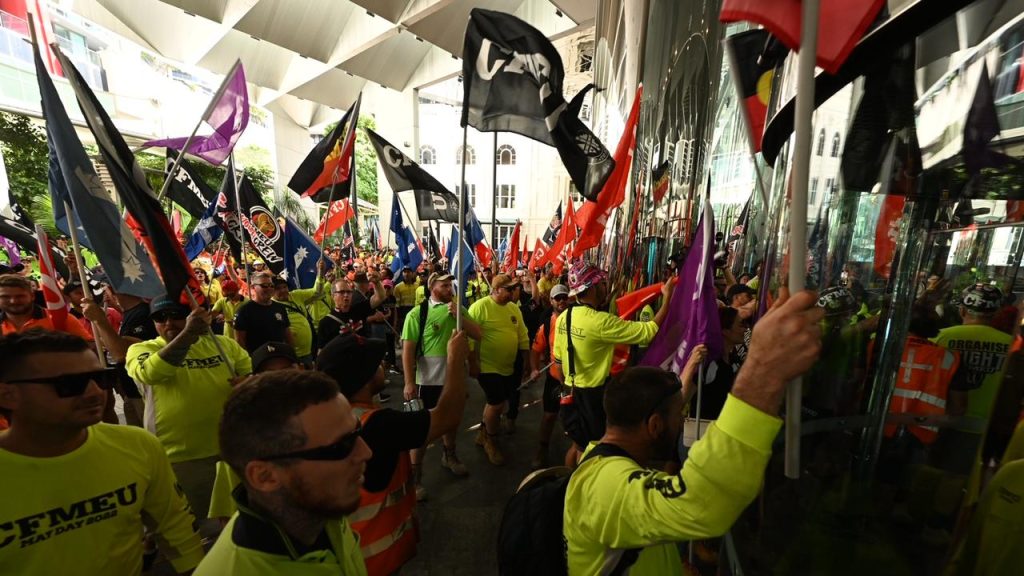
AREEA Chief Executive Steve Knott AM has penned the following Opinion piece breaking down the real motivations behind the ALP’s controversial industrial relations reforms.
Referencing last week’s public demonstrations by the CFMMEU in which Government property was damaged, he says union revenues, political donations and forcing people back into union membership are the real drivers of the political agenda.
When it comes to the ALP and IR reform, the term “follow the money”, popularised by 1976’s All the President’s Men, explains most things.
The adage helps explain why the Albanese Government so quickly abandoned its public narrative as being moderate and business-friendly, to aggressively ushering in a drastic pro-union overhaul of Australia’s workplace laws.
Make no mistake unions are demanding further paybacks and privileges from the ALP for their political donations. Witness Wednesday’s clogging of the streets in Brisbane, Sydney and Melbourne with left wing union bosses demanding unrestricted rights to strike, 8 percent wage increases and requests bordering on almost unfettered union access to work sites.
Last month former Productivity Chairman Professor Gary Banks belled the cat when he said the ALP’s IR expanded access to multi-employer bargaining, was “designed to further boost union power, under the pretext of ‘getting wages moving and job security’ ‘’.
Unions are, of course, the biggest donors to the Australian Labor Party.
In January this year the Australian Electoral Commission revealed unions made $16 million in direct payments to the ALP in 2022 and spent an additional $21m on other election campaign activities.
To fund these political donations, unions today draw revenues from a variety of sources, including redundancy funds, income protection insurance, investment returns and other commercial activities.
Membership, however, remains the largest source of income for most.
It’s therefore not rocket science to realise union membership and the financial strength of the ALP are intrinsically linked.
The ABS statistics reflect that only 8 per cent of private sector employees, or one in 12, are now members of a trade union. Within Australia’s younger generation of workers aged 20-24, this is even lower at 5 per cent.
For employers with long term direct and co-operative working arrangements with their employees, addressing declining union membership and relevance appears to be the sole motivation behind the Albanese Government’s 296-pages of “Secure Jobs, Better Pay” amendments made to the Fair Work Act last December.
It’s been four months since the amendments were passed by Parliament and employers are still coming to terms with the magnitude of workplace changes bestowed upon them.
While some of the more controversial changes such as multi-employer bargaining and various new arbitration powers for the Fair Work Commission commence in June, many have already taken effect.
By far the most disruptive for workplaces is Part 15 giving unions new powers to force renegotiation of expired enterprise agreements.
The change means unions no longer require the support of most employees covered by an expired enterprise agreement (that is no more than five years past expiry) to commence bargaining for a replacement.
Under the new system a union only needs authorisation of a single employee to drag employers back to the bargaining table.
Employers in the resources and energy industry, and no doubt many other sectors of the economy, have been notified by various unions that they intend to initiate bargaining to replace various expired agreements, many of which are irrelevant to many modern workplaces and offer diddly squat value to employers or employees.
So why force employers to negotiate with unions and update expired enterprise agreements when their workforce have sound pay and conditions, are well treated and have no desire to return to last century them and us union led enterprise bargaining?

Follow the money.
The ALP’s recent IR changes (with more anti-employer changes in the pipeline) are nothing more than lazy, opportunistic policy to try and reverse the steep decline in both enterprise agreements and private sector union membership.
The by-product here is one shoring up future union revenues and ALP funding.
The same reasoning can be applied to why the ALP is so intent on regulating the ‘gig economy’ and making labour hire arrangements more costly, cumbersome and risky for businesses to engage in.
It’s not a coincidence people who engage in these types of working arrangements, which aside from a small minority are perfectly legitimate, productive and mutually rewarding, are by and large entities where union membership is all but non-existent.
It is understandable that union bosses and the ACTU are leaning on the ALP to shore up its political influence and revenue sources. Put simply, for decades now, declining membership reflects that unions have been unable to win the hearts and minds of workers, in particular younger generations of workers.
Unsurprisingly several union bosses are now lobbying the ALP to making non-union members pay “bargaining fees” for union-led enterprise agreements; agreements most aren’t interested in or need?
Recently, the ACTU’s president made the silly claim declining membership was the result of “anti-union” laws and “suppression of worker’s rights”.
Union membership has been falling throughout the western world since Generation X entered the workforce.
By far the biggest period of decline was under Bob Hawke and Paul Keating. From 1983-1996 union membership, both public and private sector, fell from over half the workforce to one-third.
Conversely, throughout the Howard era of workplace deregulation union membership fell only 1.2% on average each year, around half the rate of the prior ALP years.
The past nine years of Coalition government saw union membership decline by 0.6% annually, on average.
The clear conclusion is declining union membership is a long-term generational and cultural trend. It’s more dramatic in the United States, where January’s data shows private sector union membership at 6%, despite strong employment growth.
The ALP and ACTU must know that legislation alone can’t make unions more appealing to the modern workforce.
Clearly that’s not the objective of their joint vision to restructure Australian workplaces; they’d rather kill off employment arrangements where unions aren’t involved than make the value proposition to individuals as to why they should join trade union.
As per the President’s Men, it all comes down to the money.



